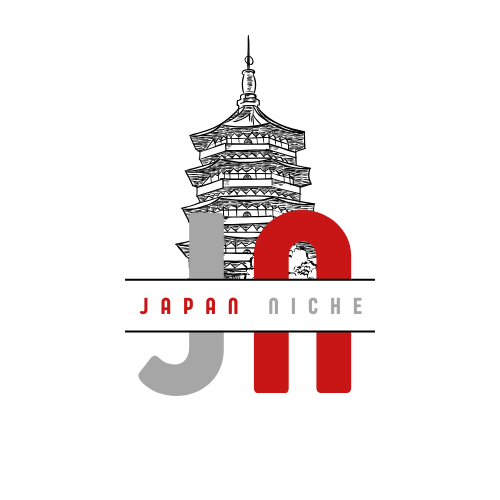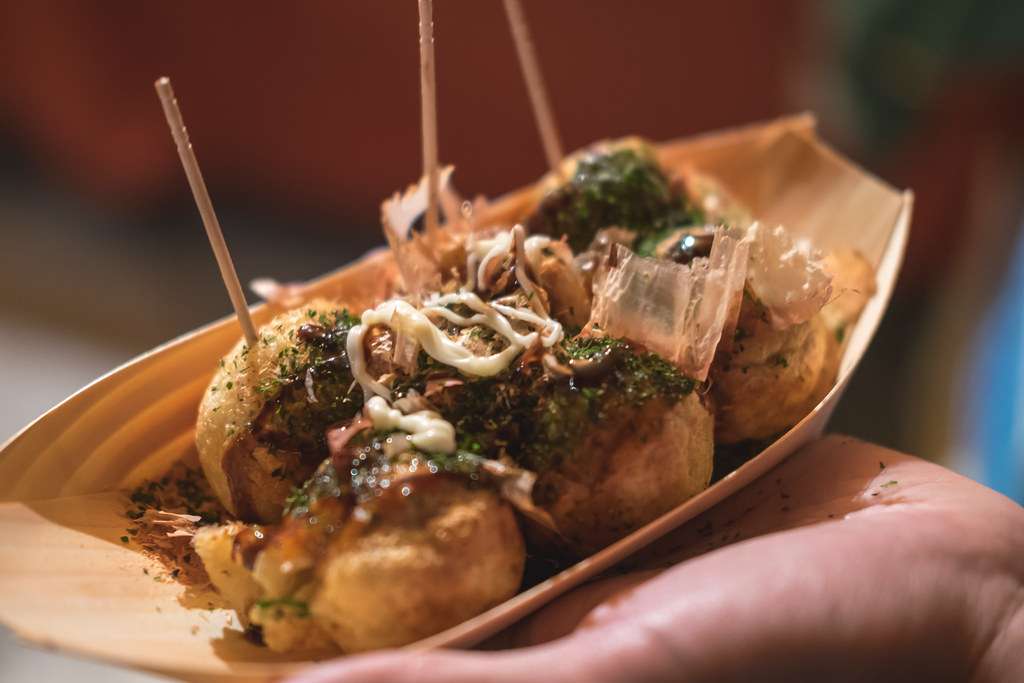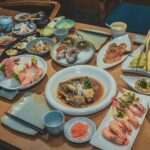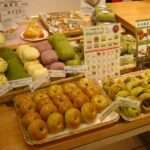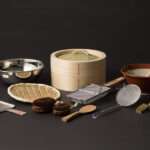Did you know that Japan has over 78,000 street food vendors across the country? I’ll never forget my first encounter with Japanese street food – standing in the bustling Dotonbori district of Osaka, watching in amazement as a vendor expertly flipped dozens of takoyaki balls with lightning speed. The sizzling sound, the mouthwatering aromas, and the energetic atmosphere completely drew me in. After spending years exploring Japan’s food scenes and learning from local vendors, I’ve discovered that street food isn’t just about satisfying hunger – it’s an essential part of Japan’s cultural fabric.
Popular Japanese Street Food Varieties
Let me tell you about my absolute favorite part of exploring Japan – diving into the incredible world of street food! After countless food adventures and, yes, quite a few burnt tongues, I’ve learned the ins and outs of navigating these delicious streets. Here’s my detailed guide to help you explore with confidence.
Takoyaki (たこ焼き)
You haven’t truly experienced Japanese street food until you’ve watched a takoyaki master at work! I remember my first time in Osaka, standing mesmerized as the vendor deftly flipped dozens of these octopus-filled balls in their special molded grill. Here’s what you need to know about these golden spheres of goodness.
The first thing that caught me off guard was the temperature – these babies come out HOT! I learned the hard way that you need to wait a few minutes before diving in. The perfect takoyaki has a crispy exterior that gives way to a creamy, almost custard-like interior with a tender piece of octopus at its heart.
Pro tip: Look for stands where the vendor keeps their batter moving constantly – this creates that ideal crispy-creamy contrast. My favorite spot in Osaka’s Dotonbori district even adds a special dashi stock to their batter, giving it an extra umami kick that sets it apart from the rest.
Yakitori (焼き鳥)
There’s something magical about the smell of chicken grilling over binchotan charcoal! After trying literally hundreds of yakitori stands (tough job, I know!), I’ve learned that the best ones keep it simple. The real art is in the timing and temperature control.
My go-to order always starts with negima (chicken and green onion). It’s the perfect way to judge a yakitori stand’s quality. The chicken should be juicy, with perfectly caramelized edges, while the green onion should be tender but still have a slight crunch.
Here’s a secret most guidebooks won’t tell you: the best yakitori stands often have a “staff meal” option (known as makanai) that they’ll serve to customers in the know. It’s usually a rice bowl topped with chicken that didn’t make the cut for skewers appearance-wise but tastes just as amazing. Just ask politely if they offer makanai – the worst they can say is no!
Taiyaki (たい焼き)
The first time I saw taiyaki being made, I couldn’t believe the precision involved in creating these fish-shaped treats. The batter needs to be just right – too thick and it becomes heavy, too thin and it loses that crucial crispy exterior.
I’ve discovered that the best time to get taiyaki is actually in the morning when many vendors are testing their batter consistency for the day. That’s when you’ll often get the most perfectly crafted ones. The traditional red bean paste filling is wonderful, but don’t overlook some of the modern variations. I once had a custard-matcha swirl filling in a shop in Asakusa that literally stopped me in my tracks!
Okonomiyaki (お好み焼き)
Let me settle a friendly debate I often see among food tourists: Osaka-style versus Hiroshima-style okonomiyaki. After trying both more times than I can count, I’ve learned they’re both amazing for different reasons. The Osaka style, with its ingredients mixed together, gives you a perfect blend of flavors in every bite. The Hiroshima style, layered with noodles, creates an incredible textural experience.
One tip I wish someone had told me earlier: watch how the locals eat it. They often cut it into smaller pieces and eat it right off the grill using their smaller spatula. And contrary to what you might think, it’s totally okay to ask for less or more sauce – the vendors want you to enjoy it your way!
Here’s a fun fact I learned from a vendor in Hiroshima: the layering technique used in their style of okonomiyaki was originally developed to make the dish more filling during post-war food shortages. Now it’s become an art form, with some chefs training for years to perfect their technique.
When it comes to toppings, don’t skip the bonito flakes (katsuobushi)! Watching them “dance” from the heat of the okonomiyaki is part of the experience. And if you’re feeling adventurous, ask for a double portion of the crispy tempura bits (tenkasu) – they add an amazing crunch that contrasts beautifully with the softer textures.
Remember, the word “okonomi” literally means “how you like it,” so don’t be afraid to customize your order. Most vendors are happy to accommodate preferences, whether you want extra cabbage, a specific protein, or a different sauce combination. Just be polite when asking, and you’ll often be rewarded with an extra-special creation!
Best Locations for Street Food
Over my years exploring Japan’s food scene, I’ve discovered that finding the best street food isn’t just about what you eat – it’s about where and when you eat it. Let me share some insider knowledge about my favorite food districts that I’ve gathered through countless delicious research missions!
Osaka’s Dotonbori District
Remember how I mentioned getting mesmerized by those takoyaki vendors? Well, Dotonbori is where that magic happened! This place is literally food heaven, and I’ve probably spent more evenings here than I care to admit. The key is knowing when to go and where to look.
Here’s something most tourists miss: the best time to visit isn’t actually during peak dinner hours. I’ve found that arriving around 4:30 PM lets you watch the vendors setting up, and you can often grab the first, freshest batches of the day. Plus, the lines are way shorter!
My secret spot? There’s a small alley just off the main strip, behind the famous Glico running man sign. Most tourists walk right past it, but it’s home to some of the best yakitori I’ve ever tasted. Look for the stand with the blue noren curtains – the owner has been grilling chicken for over 40 years!
One word of caution though – avoid the places with too many English menus out front. The best spots usually have a mix of locals and tourists, not just one or the other. And don’t be put off by lines! I once waited 45 minutes for kushikatsu (fried skewers) at a tiny eight-seat counter, and it was absolutely worth every minute.
Tokyo’s Asakusa Area
Asakusa holds a special place in my heart because it’s where I first learned to appreciate the artistry of Japanese street food. The area around Sensoji Temple is like a living museum of traditional street snacks, but with a modern twist.
Here’s a pro tip that’s served me well: start your food adventure at the end of Nakamise Shopping Street furthest from the temple. Most visitors do the opposite, which means you’ll find shorter lines and often fresher food. The ningyo-yaki (small filled cakes) stand near the end of the street makes them fresh throughout the day – when you see steam rising from their molds, that’s your cue to queue up!
I discovered this amazing spot for age-manju (fried sweet buns) purely by accident during a rainy day. It’s in a covered side street to the right of the temple, and the owner adds a special hint of citrus to her batter that makes them absolutely irresistible. Just look for the yellow curtains and the constant stream of local elderly customers – they know their stuff!
Festival Food Markets
If you really want to experience Japanese street food in its element, you’ve got to hit up the festivals. Each matsuri (festival) has its own special offerings, and I’ve made it my mission to try as many as possible!
The Sapporo Festival in winter transformed my understanding of cold-weather street food. Picture this: it’s -5°C (23°F), and you’re warming your hands on a piping hot cup of amazake while waiting for your freshly grilled corn on the cob, slathered in miso butter. Pure bliss! The secret here is to look for vendors wearing traditional happi coats – they’re often part of long-standing food associations and really know their stuff.
During summer festivals, timing is everything. I learned (the hard way) that the best strategy is to arrive about an hour before peak dinner time. This way, you avoid the worst crowds but still get to enjoy the lively atmosphere. And always, always keep an eye out for the yakisoba stands where the noodles are being stir-fried in small batches – that’s where you’ll find the perfect texture!
Tips for Enjoying Japanese Street Food
Timing Your Visit
Let me share something I wish I’d known during my first street food adventures: timing isn’t just about avoiding crowds – it’s about catching foods at their absolute best. Through plenty of trial and error (and yes, a few disappointments), I’ve figured out the perfect timing strategy.
Early birds catch the freshest morning specialties! Around 10 AM is actually a secret sweet spot – vendors have settled into their rhythm, but the lunch crowds haven’t arrived yet. Plus, this is often when they’re making fresh batches of staples like nikuman (steamed buns).
For evening ventures, I’ve found that arriving between 4:30-5:00 PM is ideal. You get to watch the vendors prep (which is honestly half the fun), and you’re there when everything’s fresh off the grill or out of the fryer. Trust me, there’s nothing quite like being the first customer of the evening shift!
Etiquette and Ordering
Over the years, I’ve had my share of awkward moments learning proper street food etiquette in Japan. Now I can help you avoid those same mistakes! First things first: despite what you might have seen in other countries, eating while walking (aruki-gui) is generally frowned upon in Japan. I once got some very polite but firm head shakes when I tried to munch on my taiyaki while strolling through a shopping arcade.
Here’s a handy hack I’ve developed: look for the wooden benches or standing tables that are usually tucked away near food stalls. These are your best friends! And if you can’t find any, simply step to the side of the stall and enjoy your food there. The vendors actually appreciate this because it keeps their serving area clear.
When it comes to payment, cash is still king in the street food world. I make sure to break my larger bills at convenience stores beforehand – vendors really appreciate exact change or close to it. And here’s a little trick: keep your coins in an easily accessible pocket. Nothing holds up a line like someone digging through their bag for change!
Remember those Japanese phrases I mentioned? Here are the absolute essentials I use daily:
- “Sumimasen” (Excuse me/Sorry) – Perfect for getting attention politely
- “Hitotsu onegaishimasu” (One please) – Just point and use this!
- “Oishi desu!” (It’s delicious!) – Vendors love hearing this
- “Arigato gozaimasu” (Thank you) – Never forget this one!
And here’s my number one tip for ordering: when you see something interesting but aren’t sure what it is, just point and say “Kore wa nan desu ka?” (What is this?). Nine times out of ten, the vendor will either explain or, even better, offer you a sample. Some of my favorite discoveries happened exactly this way!
Seasonal Specialties
One of the things that amazes me most about Japanese street food is how it changes with the seasons. After experiencing all four seasons multiple times, I’ve learned that timing your visit can completely transform your street food adventure. Let me share some seasonal secrets I’ve discovered!
Summer Street Foods
Summer in Japan can be intensely humid, but that’s exactly why they’ve perfected the art of refreshing street foods! I’ll never forget my first experience with kakigōri (shaved ice) in the middle of an August heatwave. It wasn’t anything like the snow cones I was expecting – this was a cloud of impossibly fine ice that literally melted on my tongue.
The secret to finding the best kakigōri? Look for vendors who use natural flavorings rather than artificial syrups. My favorite spot in Tokyo’s Yanaka district makes their own syrups from seasonal fruits. Their muskmelon kakigōri is worth every yen of its slightly higher price tag!
Speaking of summer fruits, don’t miss the fresh cut pineapple with special dipping salts. I was skeptical at first, but the combination of sweet fruit with salty-sour seasoning is absolutely mind-blowing. Pro tip: if you see a vendor offering honey-lemon salt as a dipping option, that’s the one to try!
Grilled corn might sound basic, but Japanese yaki-tomorokoshi is on another level. They brush it with a sweet-savory sauce while grilling, creating these amazing caramelized spots. The best vendors will have a small fan blowing across their grills – this creates the perfect char while keeping the kernels juicy.
Winter Warmers
Winter street food in Japan taught me that cold weather can actually enhance the food experience. There’s something magical about huddling around a steaming oden cart on a chilly evening, watching the vendor carefully select each piece from the simmering broth.
Here’s an oden ordering tip I learned from a local: start with the daikon (radish). It absorbs all the flavors of the broth and acts as a perfect introduction to the complexity of the dish. Also, don’t be afraid to ask “Osusume wa nan desu ka?” (What do you recommend?) – oden vendors take pride in knowing exactly which items are at their peak that day.
Roasted sweet potatoes (yaki-imo) from street vendors are nothing like what you might expect. The first time I tried one, I was blown away by how different it was from oven-roasted versions. The vendors use special stone-lined ovens that cook the potatoes super slowly, resulting in an almost dessert-like sweetness. Listen for the “Yaki-imo~” singing vendors – it’s one of winter’s most charming street food traditions!
Hot amazake is another winter treasure that too many visitors miss. Most people think it’s sake, but it’s actually a non-alcoholic fermented rice drink that’s incredibly warming and nutritious. The best vendors make it fresh daily and serve it at just the right temperature – hot enough to warm you up but not so hot that you can’t taste its subtle sweetness.
As for nikuman (steamed buns), here’s something I discovered by chance: some vendors stuff them with seasonal ingredients. In winter, you might find special editions filled with sweet potato or even curry. My personal favorite is the yuzu-kosho chicken version that appears in late winter – the citrusy-spicy kick is perfect on a cold day.
After years of exploring Japan’s street food scene, I can honestly say that these humble street stalls have taught me more about Japanese cuisine than any fancy restaurant ever could. Each vendor is a master of their specific craft, often perfecting a single dish over decades. Their dedication to quality and tradition, even in the simplest foods, is what makes Japanese street food truly special.
Remember, the best experiences often come from being open to trying new things. That mysterious-looking stall with the long line of locals? That’s your cue to join the queue. The vendor who’s been quietly grilling the same thing for 40 years? They’re probably serving some of the best food you’ll ever taste.
One final piece of advice: take your time. Japanese street food isn’t just about satisfying hunger – it’s about experiencing a vital part of the country’s food culture. Watch the vendors work their magic, chat with fellow customers if you can, and savor each bite. These moments, these flavors, they’re what make traveling in Japan so unforgettable.
I’d love to hear about your own Japanese street food adventures! Have you tried any of these dishes? Do you have a favorite vendor or location? Share your experiences in the comments below – there’s always more to discover in Japan’s amazing street food scene!
Remember to check local festival schedules before your trip, as many of the best street food experiences happen during seasonal celebrations. And don’t forget to bring cash, an appetite, and a sense of adventure. Happy eating, or as they say in Japan, “Meshiagare!”

